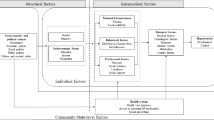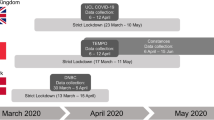Abstract
The relationship between negative events, neighbourhood characteristics, and systolic blood pressure in developing countries is not well-documented, particularly using longitudinal data. To explore this relationship, we analysed panel data from the first three waves of the South African National Income Dynamics Study using a correlated random effects model adjusted for confounding risk factors. Our sample comprised of 15,631 respondents in 2008, 14,443 respondents in 2010/2011, and 14,418 respondents in 2012, all aged above 15 years. The prevalence of at least one negative household event across the three waves was approximately 30%. In any of the three waves, the adjusted prevalence of hypertension was 23.84%. This share was 21.75% in 2008 (95% CI 18.06–25.44), 23.16% in 2010/11 (95% CI 19.18–27.14), and 18.39% in 2012 (95% CI 16.03–20.75). In our adjusted correlated random effects model, we found that systolic blood pressure was significantly higher among respondents from households that reported death of a household member (0.85 mmHg; p = 0.02) and a reduction in grant income and remittances (2.14 mm Hg; p = 0.01). We also found no significant association between systolic blood pressure and neighbourhood income level. In a country with social and economic challenges, our results indicate that grief and negative financial events are adversely associated with blood pressure, which may explain in part the significant burden of hypertension in low- and middle-income countries.
This is a preview of subscription content, access via your institution
Access options
Subscribe to this journal
Receive 12 digital issues and online access to articles
$119.00 per year
only $9.92 per issue
Buy this article
- Purchase on Springer Link
- Instant access to full article PDF
Prices may be subject to local taxes which are calculated during checkout

Similar content being viewed by others
Data availability
Data analysed during this study can be accessed at the DataFirst website (http://www.datafirst.uct.ac.za/), upon registration. Dofiles for data analyses are available from the corresponding author.
References
GBD 2019 Risk Factors Collaborators. Global burden of 87 risk factors in 204 countries and territories, 1990–2019: A systematic analysis for the Global Burden of Disease Study 2019. Lancet 2020;396:1223–49.
Unger T, Borghi C, Charchar F, Khan NA, Poulter NR, Prabhakaran D, et al. 2020 International Society of Hypertension Global Hypertension practice guidelines. Hypertension 2020;75:1334–57.
Morenoff JD, House JS, Hansen BB, Williams DR, Kaplan GA, Hunte HE. Understanding social disparities in hypertension prevalence, awareness, treatment, and control: The role of neighborhood context. Soc Sci Med. 2007;65:1853–66.
Leyland AH, Groenewegen PP. Multilevel modelling for public health and health services research: Health in context. Cham: Springer Nature; 2020.
NCD Risk Factor Collaboration (NCD-RisC). Worldwide trends in blood pressure from 1975 to 2015: A pooled analysis of 1479 population-based measurement studies with 19.1 million participants. Lancet 2017;389:37–55.
Huang C, Webb HE, Zourdos MC, Acevedo EO. Cardiovascular reactivity, stress, and physical activity. Front Physiol. 2013;4:1–13.
Ohira T, Hosoya M, Yasumura S, Satoh H, Suzuki H, Sakai A, et al. Evacuation and risk of hypertension after the Great East Japan Earthquake: The Fukushima Health Management Survey. Hypertension 2016;68:558–64.
Diez Roux AV, Mujahid MS, Hirsch JA, Moore K, Moore LV. The impact of neighborhoods on CV risk. Glob Heart. 2016;11:353–63.
Kaiser P, Diez Roux AV, Mujahid M, Carnethon M, Bertoni A, Adar SD, et al. Neighborhood environments and incident hypertension in the multi-ethnic study of atherosclerosis. Am J Epidemiol. 2016;183:988–97.
Mujahid MS, Diez Roux AV, Morenoff JD, Raghunathan TE, Cooper RS, Ni H, et al. Neighborhood characteristics and hypertension. Epidemiology 2008;19:590–8.
Manyema M, Norris SA, Richter LM. Stress begets stress: The association of adverse childhood experiences with psychological distress in the presence of adult life stress. BMC Public Health. 2018;18:1–12.
Malan L, Malan NT. Emotional stress as a risk for hypertension in sub-Saharan Africans: Are we ignoring the odds? Adv Intern Med. 2017;2:497–510.
Liu M, Li N, Li WA, Khan H. Association between psychosocial stress and hypertension: A systematic review and meta-analysis. Neurol Res. 2017;39:573–80.
Sparrenberger F, Cichelero FT, Ascoli AM, Fonseca FP, Weiss G, Berwanger O. Does psychosocial stress cause hypertension? A systematic review of observational studies. J Hum Hypertens. 2009;23:12–9.
South African National Department of Health (NDoH), Statistics South Africa (Stats SA), South African Medical Research Council (SAMRC), ICF. South Africa Demographic Health Survey 2016. Pretoria, South Africa, and Rockville, Maryland, USA; 2019.
Statistics South Africa. Victims of Crime Survey, 2018/19. Statistics South Africa. Pretoria: Statistics South Africa; 2019.
Statistics South Africa. Quarterly Labour Force Survey Quarter 1: 2020. Quarterly Labour Force Survey. Pretoria: Statistics South Africa; 2020.
Hundenborn J, Leibbrandt M, Woolard I. Drivers of inequality in South Africa. Helsinki: UNU-WIDER; 2018. Report No.: WIDER Working Paper 2018/162.
Statistics South Africa. Inequality trends in South Africa: A multidimensional diagnostic of inequity. Statistics South Africa. Pretoria: Statistics South Africa; 2019.
World Bank. Overcoming poverty and inequality in South Africa: An assessment of drivers, constraints and opportunities. Washington, D.C: World Bank; 2018.
Mayosi BM, Flisher AJ, Lalloo UG, Sitas F, Tollman SM, Bradshaw D. The burden of non-communicable diseases in South Africa. Lancet 2009;374:934–47.
Statistics South Africa. Mortality and causes of death in South Africa, 2018: Findings from death notification. Pretoria: Statistics South Africa; 2021.
Mayosi BM, Lawn JE, Van Niekerk A, Bradshaw D, Karim SSA, Coovadia HM. Health in South Africa: Changes and challenges since 2009. Lancet 2012;380:2029–43.
Burger R, Posel D, Von Fintel M. The relationship between negative household events and depressive symptoms: Evidence from South African longitudinal data. J Affect Disord. 2017;218:170–5.
Kario K. Disaster hypertension—its characteristics, mechanism, and management. Circ J. 2012;76:553–62.
Brophy T, Branson N, Daniels RC, Leibbrandt M, Mlatsheni C, Woolard I. National income dynamics study panel user manual version 1. Cape Town: Southern Africa Labour and Development Research Unit, UCT; 2018.
Leibbrandt M, Woolard I, De Villiers L. Methodology: Report on NIDS Wave 1. Cape Town: Southern Africa Labour and Development Research Unit, UCT; 2009.
De Villiers L, Brown M, Woolard I, Daniels RC, Leibbrandt M. National Income Dynamics Study Wave 3 user manual. Cape Town: Southern Africa Labour and Development Research Unit, UCT; 2013.
GBD 2017 Risk Factor Collaborators. Global, regional, and national comparative risk assessment of 84 behavioural, environmental and occupational, and metabolic risks or clusters of risks for 195 countries and territories, 1990–2017: A systematic analysis for the Global Burden of Disease Stu. Lancet 2018;392:1923–94.
McEniery CM, Franklin SS, Cockcroft JR, Wilkinson IB. Isolated systolic hypertension in young people is not spurious and should be treated: Pro side of the argument. Hypertension 2016;68:269–75.
Wright JT, Williamson JD, Whelton PK, Snyder JK, Sink KM, Rocco MV, et al. A randomized trial of intensive versus standard blood-pressure control. N. Engl J Med. 2015;373:2103–16.
Hino H, Leibbrandt M, Machema R, Shifa M, Soudien C. Identity, inequality and social contestation in the Post-Apartheid South Africa. Cape Town: SALDRU, UCT; 2018. Report No.: SALDRU Working Paper No. 233.
Statistics South Africa. Community Survey 2016 in Brief. Pretoria: Statistics South Africa; 2016.
Browning CR, Cagney KA, Iveniuk J. Neighborhood stressors and cardiovascular health: Crime and C-reactive protein in Dallas, USA. Soc Sci Med. 2012;75:1271–9.
Chaix B, Bean K, Leal C, Havard S, Evans D, Pannier B. Individual/neighborhood social factors and blood pressure in the RECORD Cohort Study: Which risk factors explain the associations? Hypertension 2010;55:769–75.
Wooldridge JM. Econometric analysis of cross section and panel data. 2nd ed. Cambridge, Massachusetts: MIT Press; 2010.
Mundlak Y. On the pooling of time series and cross section data. Econometrica 1978;46:69–85.
Schunck R. Within and between estimates in random-effects models: Advantages and drawbacks of correlated random effects and hybrid models. Stata J. 2013;13:65–76. https://doi.org/10.1177/1536867X1301300105. Available from
Antonakis J, Bastardoz N, Rönkkö M. On ignoring the random effects assumption in multilevel models: Review, critique, and recommendations. Organ Res Methods. 2021;24:443–83.
Buckley T, Mihailidou AS, Bartrop R, McKinley S, Ward C, Morel-Kopp MC, et al. Haemodynamic changes during early bereavement: Potential contribution to increased cardiovascular risk. Hear Lung Circ. 2011;20:91–8. https://doi.org/10.1016/j.hlc.2010.10.073. Available from
Fagundes CP, Wu EL. Matters of the heart: Grief, morbidity, and mortality. Curr Dir Psychol Sci. 2020;29:235–41.
Karl S, Fallon M, Palitsky R, Martinez JA, Gündel H, O’Connor MF. Low-dose aspirin for prevention of cardiovascular risk in bereavement: Results from a feasibility study. Psychother Psychosom. 2018;87:112–3.
Stahl ST, Schulz R. Changes in routine health behaviors following late-life bereavement: A systematic review. J Behav Med. 2014;37:736–55.
Boen C, Yang YC. The physiological impacts of wealth shocks in late life: Evidence from the Great Recession. Soc Sci Med. 2016;150:221–30.
Overseas Development Institute. Inter-regional inequality facility: Sharing ideas and policies across Africa, Asia, and Latin America. Overseas Development Institute. London: Overseas Development Institute; 2006.
Pool LR, Burgard SA, Needham BL, Elliott MR, Langa KM, Mendes de Leon CF. Association of a negative wealth shock with all-cause mortality in middle-aged and older adults in the United States. J Am Med Assoc. 2018;319:1341–50.
Schwandt H. Wealth shocks and health outcomes: Evidence from stock market fluctuations. Am Econ. J Appl Econ. 2018;10:349–77.
Kwok MK, Subramanian SV, Leung GM, Schooling CM. Household income and adolescent blood pressure in a Chinese birth cohort: “Children of 1997. Soc Sci Med. 2015;144:88–95. https://doi.org/10.1016/j.socscimed.2015.09.012. Available from
Augustin T, Glass TA, James BD, Schwartz BS. Neighborhood psychosocial hazards and cardiovascular disease: The Baltimore Memory Study. Am J Public Health. 2008;98:1664–70.
Kivimäki M, Vahtera J, Tabák AG, Halonen JI, Vineis P, Pentti J, et al. Neighbourhood socioeconomic disadvantage, risk factors, and diabetes from childhood to middle age in the Young Finns Study: A cohort study. Lancet Public Heal. 2018;3:e365–73.
Matheson FI, White HL, Moineddin R, Dunn JR, Glazier RH. Neighbourhood chronic stress and gender inequalities in hypertension among Canadian adults: A multilevel analysis. J Epidemiol Community Health. 2010;64:705–13.
Wagner KJP, Boing AF, Subramanian SV, Höfelmann DA, D’Orsi E. Effects of neighborhood socioeconomic status on blood pressure in older adults. Rev Saude Publica. 2016;50:78.
Mayne SL, Moore KA, Powell-Wiley TM, Evenson KR, Block R, Kershaw KN. Longitudinal associations of neighborhood crime and perceived safety with blood pressure: The multi-ethnic study of atherosclerosis (MESA). Am J Hypertens. 2018;31:1024–32.
Sarkar C, Webster C, Gallacher J. Neighbourhood walkability and incidence of hypertension: Findings from the study of 429 334 UK Biobank participants. Int J Hyg Environ Health. 2018;221:458–68.
Svensson J, Theorell T. Life events and elevated blood pressure in young men. J Psychosom Res. 1983;27:445–55.
World Health Organization. Noncommunicable Diseases Country Profiles 2018. Geneva: World Health Organization; 2018.
Campbell N, Lackland D, Niebylski M. High blood pressure: Why prevention and control are urgent and important — a 2014 fact sheet from the World Hypertension League and the International Society of Hypertension. J Clin Hypertens. 2014;16:551–3.
Author information
Authors and Affiliations
Contributions
TG was responsible for formulating research question and developing the concept, extracting and analysing data, interpretating results, summarising findings, and writing of first and final draft. MvF contributed to the formulation of the research question, data analysis, and providing feedback on the drafts. AES provided inputs on literature and data analysis and interpretation, and reviews of the drafts. RB was the project leader and supervisor, contributed to formulation of research question, data analysis, and feedback on the drafts.
Corresponding author
Ethics declarations
Competing interests
The authors declare no competing interests.
Ethics approval
No ethical approval needed for this study because it used publicly available data, which is not sensitive and not linked to person or household identifiers. The present study, therefore, did not involve direct interaction with, or data gathering from human or organisational participants.
Additional information
Publisher’s note Springer Nature remains neutral with regard to jurisdictional claims in published maps and institutional affiliations.
Supplementary information
Rights and permissions
About this article
Cite this article
Gangaidzo, T., von Fintel, M., Schutte, A.E. et al. Stressful life events, neighbourhood characteristics, and systolic blood pressure in South Africa. J Hum Hypertens 37, 405–411 (2023). https://doi.org/10.1038/s41371-022-00695-9
Received:
Revised:
Accepted:
Published:
Issue Date:
DOI: https://doi.org/10.1038/s41371-022-00695-9



